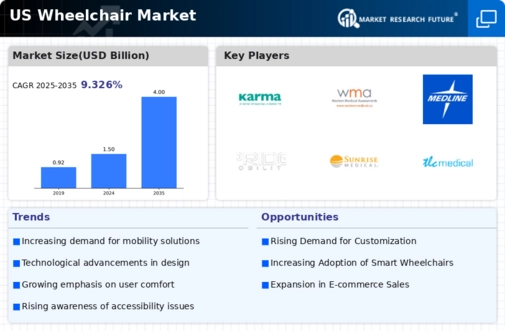Aging Population
The US Wheelchair Market is experiencing a notable increase in demand due to the aging population. As the baby boomer generation continues to age, the prevalence of mobility impairments rises. According to the US Census Bureau, by 2030, all baby boomers will be over 65, leading to a significant rise in the number of individuals requiring mobility aids. This demographic shift is likely to drive the demand for wheelchairs, as older adults often face challenges related to mobility. Furthermore, the increasing life expectancy suggests that more individuals will require long-term mobility solutions, thereby expanding the US Wheelchair Market. Manufacturers are responding by developing innovative wheelchair designs that cater to the specific needs of older adults, enhancing comfort and usability.
Technological Advancements
Technological advancements are playing a crucial role in shaping the US Wheelchair Market. Innovations such as powered wheelchairs, smart wheelchairs equipped with sensors, and advanced materials are enhancing the functionality and appeal of mobility devices. The integration of technology not only improves user experience but also addresses specific mobility challenges faced by individuals with disabilities. For instance, powered wheelchairs now offer features like obstacle detection and navigation assistance, which significantly enhance independence. The market for powered wheelchairs is projected to grow, driven by these technological innovations. As a result, manufacturers are increasingly investing in research and development to create cutting-edge products that meet the evolving needs of consumers in the US Wheelchair Market.
Rising Awareness of Disability Rights
The rising awareness of disability rights is influencing the US Wheelchair Market positively. Advocacy for the rights of individuals with disabilities has gained momentum, leading to increased demand for accessible products, including wheelchairs. Legislative measures, such as the Americans with Disabilities Act, have heightened awareness and encouraged businesses to prioritize accessibility. This shift in societal attitudes is likely to result in a greater emphasis on inclusive design in wheelchair manufacturing. As consumers become more informed about their rights, they are more inclined to seek out products that enhance their mobility and independence. Consequently, this trend is expected to drive growth in the US Wheelchair Market, as manufacturers adapt to meet the needs of a more empowered consumer base.
Healthcare Infrastructure Improvements
Improvements in healthcare infrastructure are contributing to the growth of the US Wheelchair Market. Enhanced access to healthcare services, including rehabilitation and physical therapy, is facilitating better mobility solutions for individuals with disabilities. As healthcare providers increasingly recognize the importance of mobility aids in patient recovery and quality of life, the demand for wheelchairs is likely to rise. Additionally, insurance coverage for mobility devices is expanding, making wheelchairs more accessible to a broader population. This trend is expected to stimulate growth in the US Wheelchair Market, as more individuals are able to obtain the necessary mobility aids to improve their daily lives. The collaboration between healthcare providers and wheelchair manufacturers is also fostering innovation in product development.
Customization and Personalization Trends
Customization and personalization trends are becoming increasingly prominent in the US Wheelchair Market. Consumers are seeking mobility solutions that cater to their unique needs and preferences, prompting manufacturers to offer a range of customizable options. This includes adjustable seating, personalized designs, and specialized features that enhance comfort and usability. The demand for tailored wheelchairs is likely to grow as individuals recognize the importance of having a mobility aid that reflects their lifestyle and personal style. Furthermore, advancements in manufacturing technologies, such as 3D printing, are enabling the production of bespoke wheelchairs at a lower cost. This trend towards customization is expected to drive innovation and competition within the US Wheelchair Market, as companies strive to meet the diverse needs of their customers.


















Leave a Comment